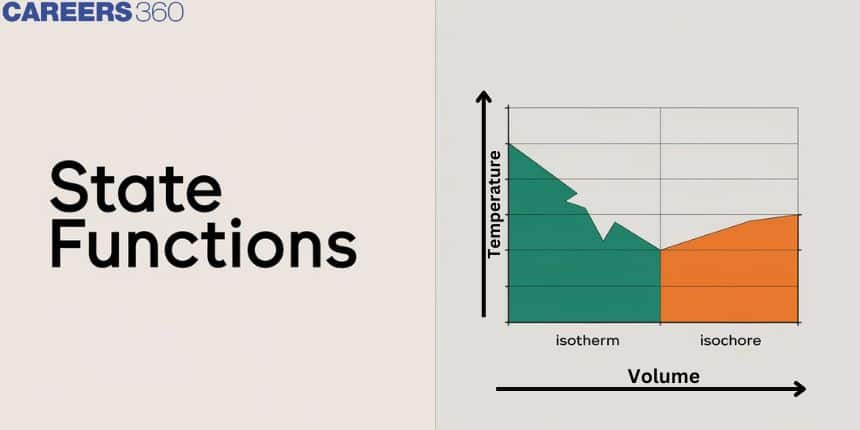State Functions
State functions are such properties of the system that depend only on the current state of the system and not on the path taken to achieve that state. These functions provide fundamental information about the equilibrium state of a system and do not turn either upon the process or transformation that the system undergoes. All the important state functions of thermodynamics include internal energy, enthalpy, entropy, Gibbs free energy, Helmholtz free energy, volume, pressure, and temperature. Each of these functions can be used to describe something about the properties and behaviors of a system.
NEET 2025: Mock Test Series | Syllabus | High Scoring Topics | PYQs
JEE Main: Study Materials | High Scoring Topics | Preparation Guide
JEE Main: Syllabus | Sample Papers | Mock Tests | PYQs
- Types of Thermodynamic Process
- Some Solved Examples
- Summary

Path and State Function
It is the path along which a change of state occurs. It is a path of change of a system from one equilibrium state or another which is usually accompanied by a change in energy or mass.
Types of Thermodynamic Process

1. Isothermal Process
Here the temperature is kept constant during each step of the process. Example,
ΔT=0,ΔE=0
It is achieved by using a thermostatic control.
Heat can be absorbed or evolved here that is, can be exchanged with the surroundings.
For example, Freezing, melting, evaporation, and condensation.
2. Isobaric Process
Here the pressure is kept constant (ΔP=0) during each step of the process.
For example, the Expansion of gas in an open system.
Vaporization and heating of water up to its boiling point occur at the same atmospheric pressure.
3. Isochoric Process
Here volume is kept constant. (ΔV=0) during each step of the process.
For example, the Heating of substance in a closed vessel (system) or non-expanding chamber.
4. Adiabatic Process
Here no exchange of heat takes place between the system and the surroundings that is, (Q = 0)
It is achieved by insulating the system or in closed insulated containers (thermos).
5. Cyclic Process
Here the System undergoes a series of changes but finally comes back to the initial state.
ΔE=0,ΔH=0
Recommended topic video on(State Functions)
Some Solved Examples
Example 1: Which one of the following is a state property or function?
1)Heat
2)Work
3)Loss of energy due to friction
4) Potential energy.
Solution
Path and state function- It is the path along which a change of state occurs. It is a path of change of a system from one equilibrium state or another which is usually accompanied by a change in energy or mass. A physical quantity is said to be a state function if its value depends only upon the state of the system and does not depend upon the path by which this state has been attained For example, a person standing on the roof of a five-storeyed building has fixed potential energy, irrespective of the fact whether he reached there by stairs or lift. Thus, the potential energy of the person is a state function.
Hence, the answer is the option (4).Example 2: Internal energy is an example of
1)Path function
2) State function
3)Both A and B
4)None of these
Solution
State Function - Any property of the system is dependent only on the state of the system and not on the path by which the system is obtained. Internal energy, Enthalpy, Entropy, Pressure, temperature, volume, etc. The function whose value depends only on the state of a system is known as the state function.
Hence, the answer is the option (2).
Example 3: Which of the following is the path function?
1)Temperature
2)Enthalpy
3) Heat
4)Entropy
Solution
Quantities are dependent on the Path by which the system has achieved a particular state. e.g. Heat, Work, Heat capacity Hence, heat is a path function.
Hence, the answer is the option (3).
Example 4: U is equal to :
1) Adiabatic work
2) Isothermal work
3) Isochoric work
4)Isobaric work
Solution
Adiabatic Process -
Heat exchange between the system and surroundings is zero.
So,
ΔE=q+w
q=0
ΔE=w
No change in internal energy = Adiabatic work
Hence, the answer is an option (1).
Example 5: A process in which volume remains constant is called:
1) Isochoric process
2)Isothermal process
3)Adiabatic process
4)Isobaric process.
Solution
Isochoric Process- Here volume is kept constant. (ΔV=0) during each step of the process, For example, the Heating of substance in a closed vessel (system) or non-expanding chamber. The process is termed isochoric in which volume remains constant throughout the change, i.e., dV=0.
Hence, the answer is the option (1).
Summary
State functions in thermodynamics are necessary to define the equilibrium state of a system regardless of the path. Internal energy, U, encompasses all kinds of energy, kinetic and potential energies, present in the system. In contrast, enthalpy, H, is defined as the sum of internal energy and the product of pressure and volume, so it expresses the total heat content. Entropy, S, comes with disorder and increases in spontaneous processes according to the second law of thermodynamics. Gibbson free energy, G, merges enthalpy with entropy to calculate the spontaneity of a process at constant temperature and pressure, with ΔG < 0 being spontaneous. Helmholtz free energy, A, does the same thing but is used at constant volume and temperature and thus gives the maximum work available. Volume, V, and pressure, P, describe both the amount of space that a substance occupies, as well as the force per unit area respectively.
Also Read
19 Feb'25 12:52 PM
19 Feb'25 10:40 AM
19 Feb'25 10:36 AM
19 Feb'25 10:35 AM
19 Feb'25 10:16 AM
18 Feb'25 11:45 PM
18 Feb'25 11:43 PM
18 Feb'25 11:40 PM
18 Feb'25 11:38 PM
18 Feb'25 11:36 PM

